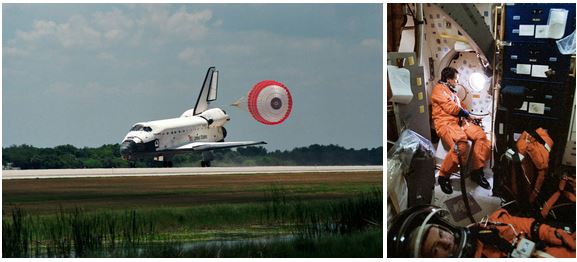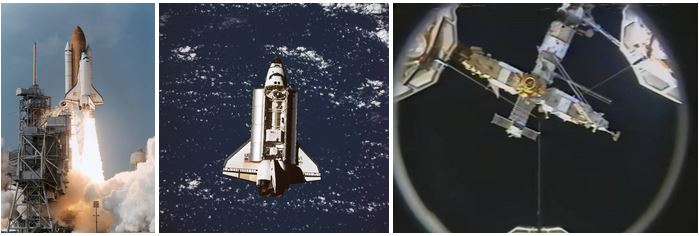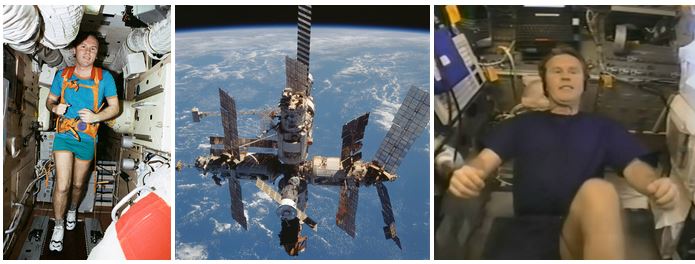Space shuttle Discovery paid the last American visit to the Russian space station Mir during the STS-91 mission in June 1998. Discovery’s six-member crew of NASA astronauts Charles J. Precourt, Dominic L. Gorie, Franklin R. Chang-Díaz, Wendy B. Lawrence, and Janet L. Kavandi, and Valery V. Ryumin of the Russian Space Agency, now Roscosmos, delivered supplies to the Mir 25 crew of cosmonauts Talgat A. Musabayev and Nikolai M. Budarin and returned NASA astronaut Andrew S.W. Thomas, completing his 141-day flight aboard Mir. The flight marked the end of the Shuttle-Mir Program, also known as Phase 1 of the International Space Station Program, established to enable the two countries to work together in preparation for the newer and more complex orbiting research facility. In its cargo bay, Discovery carried a pressurized Spacehab module and the Alpha Magnetic Spectrometer on a demonstration flight for the instrument on the International Space Station since 2011.
The Shuttle-Mir Program began in 1992 as government-level agreements between the United States and Russia to exchange crew members on their respective space vehicles, and for a long-duration flight of an American astronaut aboard Mir, followed by a docking of a space shuttle with Mir. In its expanded form of six additional long-duration flights and eight more shuttle dockings, it became Phase 1 of the International Space Station Program, providing the two countries with experience in working together in space, and giving the United States its first long-duration spaceflight experience since the Skylab program of the 1970s. In its cargo bay, Discovery carried a Spacehab single module and the Alpha Magnetic Spectrometer-01 (AMS-01) experiment. The Spacehab module contained much of the 4,700 pounds of cargo, experiments, and supplies that the crew exchanged between the Shuttle and Mir. The AMS-01, a shuttle-based precursor of the AMS-02 instrument operating on the space station since 2011, was a state-of-the-art particle physics instrument to collect data on cosmic rays and search for antimatter and dark matter, known to make up a significant portion of the mass of the universe.
Discovery, carrying its six crew members, thundered off Launch Pad 39A at NASA’s Kennedy Space Center (KSC) in Florida on June 2, 1998, headed for the Russian space station Mir in the final flight of the Shuttle-Mir Program. Discovery previously visited Mir in February 1995 during the STS-63 mission for the first Shuttle rendezvous with the station but had come no closer than 30 feet. Two days after launch, assisted by his fellow crew members, Precourt guided Discovery to a smooth docking with Mir. A few hours later, with the hatches opened between the two spacecraft, the three-member Mir-25 crew greeted the six new arrivals. Thomas, after 130 days living and working aboard Mir, became a member of the Shuttle crew for his return to Earth. His transfer wrapped up 907 days of American astronaut stays aboard the Russian space station. The nine STS-91 and Mir-25 crewmembers spent the next four days finishing up experiments on Mir and with Lawrence serving as the transfer supervisor, exchanging cargo, water, and experiment samples between the two vehicles. On June 5, Ryumin, a veteran of two six-month missions aboard Salyut-6 in the 1970s and a senior space manager, passed the 365-day mark for cumulative time in space. The crews celebrated with Musabayev playing the guitar.

the hatchway between the two spacecraft. Middle: The combined Mir 25 and STS-91 crews pose in
Mir’s Base Block module. Right: STS-91 astronaut Wendy B. Lawrence surrounded
by transfer items in the Spacehab module.
In the course of 10 days, with Chang-Díaz at its controls, AMS-01 operated for 103 hours and collected data on nearly 100 million cosmic rays, proving the technology and paving the way for the highly successful space station instrument. In addition to AMS-01, STS-91 carried other science experiments including radiation detectors and a protein crystallization facility. Thomas continued a cancer cell-growth experiment that he had begun while still aboard Mir.

Middle: Astronaut Andrew S.W. Thomas enjoys playing a guitar that first arrived on Mir in 1995.
Right: Mir 25 commander Talgat A. Musabayev, right, plays the guitar as STS-91
commander Charles J. Precourt holds the sheet music.
On June 8, the crew closed the hatches between the two vehicles, and Discovery undocked from Mir. The shuttle crew completed a fly-around inspection of the space station that included an unsuccessful experiment to try to locate the leak in the Spektr module, punctured the previous year during a collision with a Progress cargo vehicle. Gorie fired Discovery’s thrusters to finally depart from the station. Thomas commented on the departure:
“Perhaps one of the most moving moments, though, was as we drew further and further away, we went into the night side of the planet, and I could see stars, and the running lights of the station were on. You couldn’t see the station. All you could see was lights flashing, and they were just going off into the distance, these flashing points of light fading out slowly. That was kind of an emotional moment, because I knew that would be the last time I would see it.”
On June 10, Chang-Díaz, on his record-tying sixth spaceflight, broke the previous record of 50 days of cumulative time spent aboard space shuttles, held by NASA astronaut Jeffery A. Hoffman over his five space missions.

the STS-91 mission and close-out the Shuttle-Mir Program. Right: Following landing,
returning long-duration crew member Andrew S.W. Thomas, bottom, remains in his
recumbent seat while STS-91 astronaut Franklin R. Chang-Díaz looks
out the side hatch window at recovery teams.
Shortly before firing Discovery’s engines for the de-orbit burn, the crew turned off the AMS-01 experiment and closed the payload bay doors. On June 12, Precourt guided Discovery and its seven crew members to a safe landing at KSC, ending the STS-91 mission after 9 days, 19 hours, and 54 minutes. Thomas had spent 140 days, 15 hours, and 12 minutes in space. The flight closed out the successful Shuttle-Mir Program, and opened the way for assembly and operations of the International Space Station that began with the launch of its first on-orbit element in November 1998. Managers and engineers benefited from the lessons learned from Skylab to successfully implement the Shuttle-Mir program. Likewise, lessons learned from Phase 1 benefited those planning for, assembling, and eventually operating the International Space Station. Although each platform had unique attributes, they all made use of the long-duration spaceflight environment to execute a wide-ranging research and technology demonstration program.
Watch a video of the mission narrated by the STS-91 crew.





























